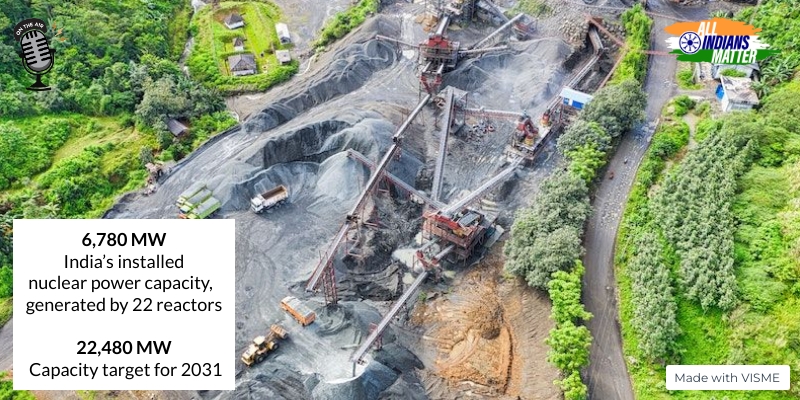Ashraf Engineer
August 12, 2023
EPISODE TRANSCRIPT
Hello and welcome to All Indians Mater. I am Ashraf Engineer.
Last week, I touched upon the Indian government throwing open lithium mining to the private sector. While lithium is important for the green economy we want to create, and for India’s energy security, its mining can have terrible effects on local communities and the environment. So, any policy that steps up lithium mining must also ensure safeguards for communities and the ecology. When that episode aired, my friend Dr Dilnaz Boga, a veteran journalist herself and a PhD holder in development studies, suggested I also talk about uranium mining in India. Dilnaz has covered the effects of the quest for uranium in the North-East, and I thought this was a timely suggestion – given that not too long ago uranium deposits were discovered in Rajasthan and the plan is to extract the mineral aggressively.
SIGNATURE TUNE
With the discovery in Rajasthan, India is a step closer to expanding uranium production. The Department of Atomic Energy first found uranium deposits there in 2012 and now it is projected that there may be 12 million tons of it.
Accordingly, a letter of intent was issued by the Rajasthan government to the Uranium Corporation of India. However, we are a long way away from actually mining it. Not all uranium can be excavated and used to generate nuclear energy nor can the quantum of the deposits be understood without a detailed geological survey.
As of December 2020, the Atomic Minerals Directorate for Exploration and Research had marked 44 uranium deposit sites in Andhra Pradesh, Telangana, Jharkhand, Meghalaya, Rajasthan, Karnataka, Chhattisgarh, Uttar Pradesh, Uttarakhand, Himachal Pradesh and Maharashtra. But not all are conducive to mining.
India also imports the mineral from countries like Kazakhstan, Russia, Uzbekistan and Canada.
Uranium is a naturally occurring element found in rocks in concentrations of 2 to 4 parts per million and used as a source of concentrated energy. As it decays, it emits invisible bursts of energy called atomic radiation. In the process, it also produces several other radioactive and unstable substances as byproducts that are discarded when uranium is mined.
India’s installed nuclear power capacity is 6,780 MW generated by 22 operational reactors. The government plans to enhance capacity to 22,480 MW by 2031. India’s only operational uranium mine is at Jadugoda in Jharkhand and the focus is on establishing more because the reserves at Jadugoda are depleting fast.
Like lithium, uranium is key to India’s green energy goals. At the COP26 Summit in Glasgow, India had committed to 500 GW of non-fossil energy production by 2030.
Nuclear energy is important also because it has one of the smallest carbon footprints. And, although nuclear reactors are costly to build, they have low running costs and great longevity. They produce more power on less land than any other clean-air source.
The North-East is the other area of focus for uranium, where the government has an ambitious plan to step up exploration. The Department of Atomic Energy has earmarked at least eight districts in Assam, Tripura and Arunachal Pradesh for exploration. In addition, 20,000 tons of uranium oxide have been confirmed in Meghalaya.
However, mining has met with protests from locals at various places across the country.
For instance, in Jharkhand, local communities have complained of land being forcefully acquired and radiation pollution having severe health impacts, including cancer. Other ailments include congenital deformities, sterility and spontaneous abortions. In Jadugoda, media reports have said that women who suffer from radiation-related problems are treated as social outcasts.
Villagers have even complained of radioactive waste being dumped by the roadside.
Surveys conducted by independent agencies, such as Japan’s Kyoto University and India’s Jadhavpur University, have confirmed radiation pollution in the air, water and soil. The studies showed that there was a spike in congenital deformities, as well as chronic lung disease, after mining operations began in 1967.
What’s worse is that Adivasis workers are often assigned hazardous tasks. Media reports have in the past detailed how Adivasis entered the 260-mt-deep Turamdih mine and had to clear it while immersed in wet radioactive slurry. Several workers, the reports said, died.
The reports added that the slurry was not supposed to be removed manually but by machines and then flushed into the tailing dam through special pipes
These workers are often not employees of the Uranium Corporation. Instead, they are employed by contractors, who then employ subcontractors. This means not just cheap labour for the Uranium Corporation but also an excuse to shift blame to the contractors when something goes wrong.
A Right to Information query showed that some of these contractors didn’t even have a licence to operate.
The Adivasis in Jadugoda, meanwhile, have few options. They were displaced from their homes for the mining operations and promised permanent jobs with the Uranium Corporation. In many cases, that doesn’t seem to have happened.
There is little doubt that India needs to explore and invest in green energy production. However, as I had argued on the subject of lithium mining, it can’t be at the expense of local, unempowered communities and the destruction of the very environment you are trying to save. Polluted water, soil and air, fractured communities dealing with radiation poisoning, forests with deep gashes in the form of mines, tribals thrown out of their homes, animals driven away… This can’t be the price we pay to achieve our sustainable energy goals. There must be a better way.
Thank you all for listening. Please visit allindiansmatter.in for more columns and audio podcasts. You can follow me on Twitter at @AshrafEngineer and @AllIndiansCount. Search for the All Indians Matter page on Facebook. On Instagram, the handle is @AllIndiansMatter. Email me at editor@allindiansmatter.in. Catch you again soon.






